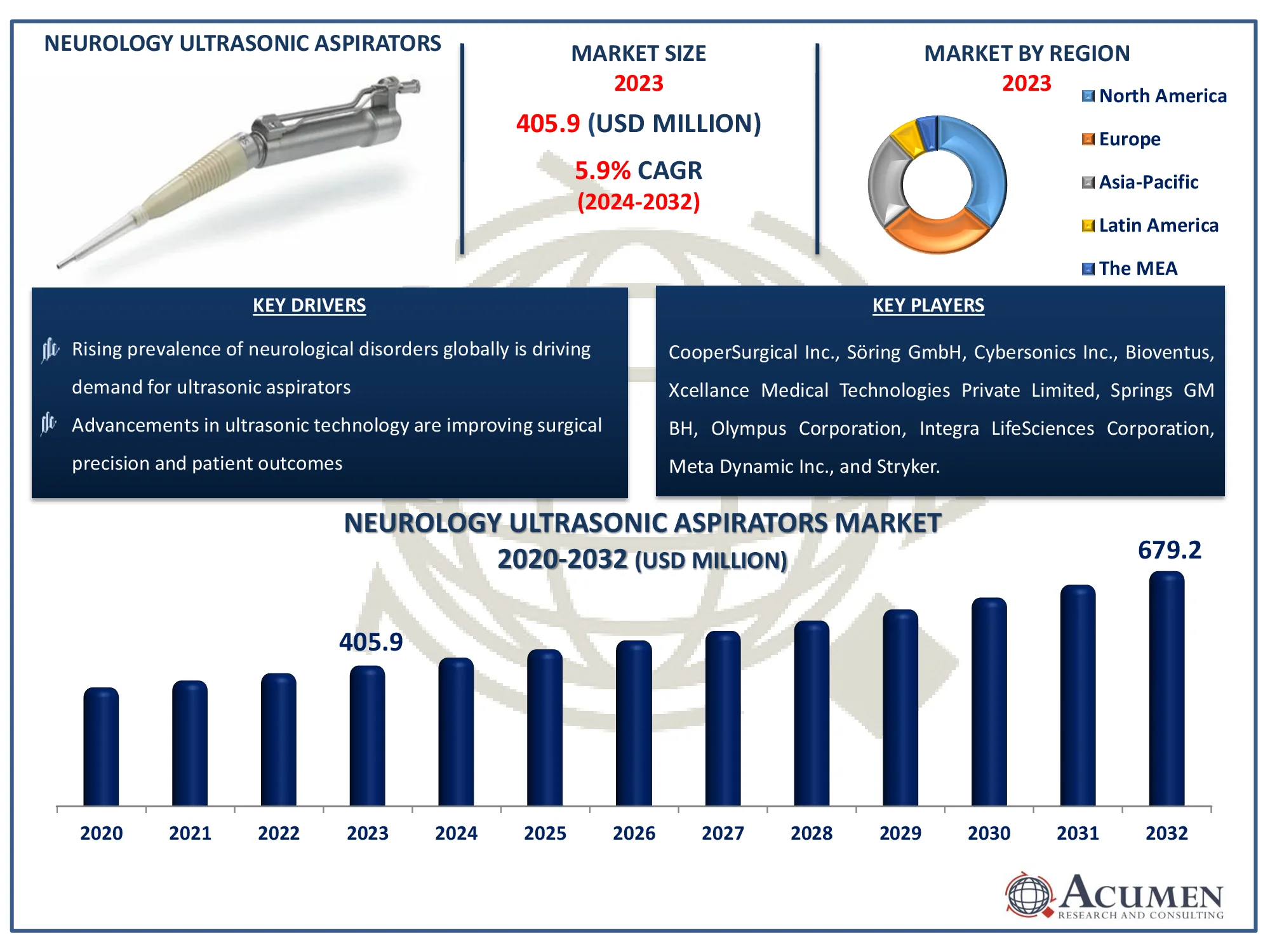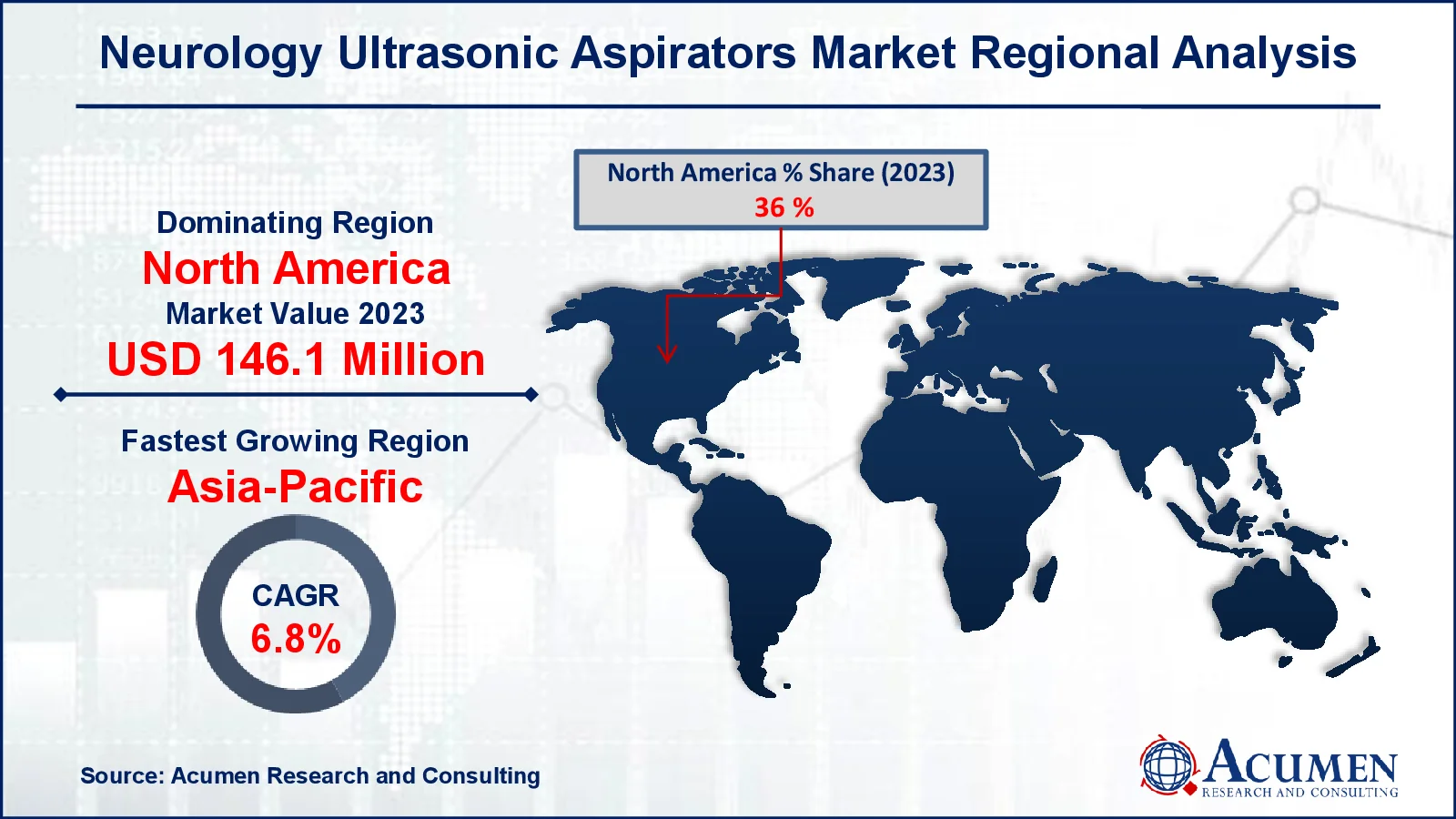March 2023
The Global Neurology Ultrasonic Aspirators Market Size accounted for USD 405.9 Million in 2023 and is estimated to achieve a market size of USD 679.2 Million by 2032 growing at a CAGR of 5.9% from 2024 to 2032.
The Global Neurology Ultrasonic Aspirators Market Size accounted for USD 405.9 Million in 2023 and is estimated to achieve a market size of USD 679.2 Million by 2032 growing at a CAGR of 5.9% from 2024 to 2032.
Neurology Ultrasonic Aspirators Market Highlights

Ultrasonic aspirants are instruments used for surgery to remove difficult or soft tissues, fluids or air from cavities. Ultrasonic tissues are also used. The ultrasonic suction unit comprises primarily a container in which the vacuum is produced by an air suction pump owing to the reverted air pressure. There is also a handpiece used for the removal of tissue, liquid or air. The hand piece shape may be straight or angular. The hand part can differ by size as well. Leading companies give sophisticated ultrasonic aspirators which, depending on the application, can be operated via three distinct frequencies.
Global Neurology Ultrasonic Aspirators Market Dynamics
Market Drivers
Market Restraints
Market Opportunities
Neurology Ultrasonic Aspirators Market Report Coverage
|
Market |
Neurology Ultrasonic Aspirators Market |
|
Neurology Ultrasonic Aspirators Market Size 2023 |
USD 405.9 Million |
|
Neurology Ultrasonic Aspirators Market Forecast 2032 |
USD 679.2 Million |
|
Neurology Ultrasonic Aspirators Market CAGR During 2024 - 2032 |
5.9% |
|
Neurology Ultrasonic Aspirators Market Analysis Period |
2020 - 2032 |
|
Neurology Ultrasonic Aspirators Market Base Year |
2023 |
|
Neurology Ultrasonic Aspirators Market Forecast Data |
2024 - 2032 |
|
Segments Covered |
By Product, By End Use, and By Geography |
|
Regional Scope |
North America, Europe, Asia Pacific, Latin America, and Middle East & Africa |
|
Key Companies Profiled |
Werner, Louisville Ladder, Little Giant Ladders, Zhejiang Aopeng, Foshan Wright, Bauer Corporation, FACAL, Chongqing Xituo, HCAC Ladder, and Elkop Ltd. |
|
Report Coverage |
Market Trends, Drivers, Restraints, Competitive Analysis, Player Profiling, Covid-19 Analysis, Regulation Analysis |
Neurology Ultrasonic Aspirators Market Insights
Increased numbers of neurological disorders, including traumatic brain injury (TBI), minimally invasive neurochirurgical procedures and an growing consciousness of the professional neurology aspirator are some of the variables that drive the development. Neurological ultrasound aspirators are surgical instruments used to dissect tissues and aspirate the surgical field with low frequency ultrasound vibrations. Neurological ultrasound aspirators were used to remove brain tumors according to the National Center of Biotechnology Information (NCBI). Cavitron Ultrasonic Surgical Aspirator (CUSA), for example, is intended to remove a brain tumor without influencing the tissue of heat.
Neurological ultrasonic vacuum cleaners offer several advantages such as the most versatile and user-friendly soft tissue control system. Perioperative morbidity and blood loss intraoperatively can be reduced. It allows a delicate brain structure to be dissected in a closed environment with fine bone. It is used extensively in several specialties of surgery and is used to perform minimally invasive processes. The increasing prevalence of neurological conditions like brain tumors and TBI is driving development on the market. The average death rate of brain tumor in the United States is 16,616, according to National Brain Tumor Society (NBTS).
Neurology Ultrasonic Aspirators Market Segmentation
The worldwide market for neurology ultrasonic aspirators is split based on product, end use, and geography.
Neurology Ultrasonic Aspirator Market By Products
Stand-alone ultrasonic neurology aspirators are expected to become market leaders as cerebral paralysis, bone dissection, and head injuries become more widespread. This sector is the market leader in neurology ultrasonic aspirators due to factors such as lower injury risk, simple designs, and lower treatment costs. This product has a simple configuration that allows the user to automatically adjust energy and achieve precise fragmentation, watering, and suction.
According to neurology ultrasonic aspirators industry analysis, due to the increase incidence of brain tumours and neurological disabilities, integrated neurology is expected to be the most rapidly growing segment during the forecast period. It enables surgeons in complicated cranial neurology combine and aspire soft tissue. This technology is used in surgery on the basis of orbital, tearful, neurological and cranial conditions. Sonoca 300 Ultrasound aspirator was developed for Soering, for example, to give three work frequencies in one scheme. It is used for neurochirurgical procedures.
Neurology Ultrasonic Aspirator Market By End Uses
Due to the growing incidence of neurological diseases such as brain injury and TBI, the hospitals segment leads the neurology ultrasonic aspirators market. There is a distinct neurology department in hospitals known as the neurology and scientific department. The main focus of this department is on different illnesses, abnormality and brain, spinal and neural dysfunction. They have a specialization in neurology, neuropsychology and neurorehabilitation. Their neurochirurgical theatres, like microsurgic instrumentations, neuroendoscopy (appliances) and spinal instrumentation, are well equipped with surgical equipments. They also use neurology ultrasonic surgical aspirators to treat minimally invasive neurochirurgics. It is used mainly in brain tumors and TBI therapy. Thus, growing abnormalities and brain illnesses and improved hospital health equipment are driving the development of the neurology ultrasonic aspirators market.
Outpatients that do not need overnight stays after surgery are best recognized in Ambulatory Surgical Centers (ASC). More comfort and cost reduction include outpatient surgery benefits. ASCs are specialized in a number of operational therapies, for example, pain management, neurosurgery and diagnosis. In the U.S. there are 5,260 operating centers compared to 5,724 hospitals, according to the American Hospital Association. Thus the ASC Segment drives over the forecast period variables such as cost savings and reductions of overnight stays.
Neurology Ultrasonic Aspirators Market Regional Outlook
North America
Europe
Asia-Pacific
Latin America
The Middle East & Africa

Neurology Ultrasonic Aspirators Market Regional Analysis
North America was the market leader. It was also anticipated, because neurological diseases are increasingly prevalent, therapy awareness, presence of well-established healthcare centers, and accessibility of extremely qualified neurochirurgs, to be seen significant development in future. In addition, the market should also be driven by important acceptance of technologically sophisticated medical kinds. Moreover, increased refunds for device and surgical technologies are having a positive effect on regional development.
In the near future as a result of diseased predominance, increased public initiatives and numerous non-governmental awareness programs, Asia Pacific is anticipated to register as the fastest CAGR during the neurology ultrasonic aspirators market forecast period. In economies like China and Japan there are a big number of main players that drive development significantly. Another main driver of regional development is the increase in brain tumors and TBI.
Neurology Ultrasonic Aspirators Market Players
Some of the top neurology ultrasonic aspirators companies offered in our report includes META Clinical Services, CooperSurgical Inc., Söring GmbH, Cybersonics Inc., Bioventus, Xcellance Medical Technologies Private Limited, Springs GmbH, Olympus Corporation, Integra LifeSciences Corporation, and Stryker.
Looking for discounts, bulk pricing, or custom solutions? Contact us today at sales@acumenresearchandconsulting.com
March 2023
July 2022
March 2025
November 2020